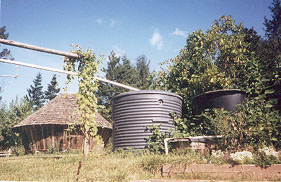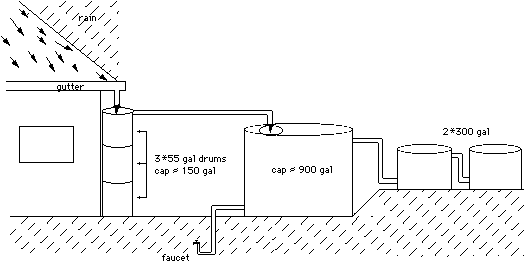Anonymous1 (talk | contribs) |
Tag: n |
||
| Line 11: | Line 11: | ||
* Rain gutters | * Rain gutters | ||
* | * standpipe connecting to the rain gutters | ||
* 150 gallon drum | * 150 gallon drum | ||
Revision as of 07:08, 26 September 2012
- This page describes several systems. It should probably be broken up into separate pages, with some moved to a main topic page, some to a general how-to page (both of these combined with other existing rainwater pages) and a number of specific design pages.
Rainwater Catchment System
The rainwater catchment system is based on collection of rainwater and gravity flow pressure principles.[1] Whenever it rains, the rainwater runs off the roof of the house and into rain gutters. Then, the rain filled gutters tunnel the water and empty it into a standpipe. When the standpipe has reached its maximum capacity of 150 gallons, the overflow of the rainwater runs through a pipe and empties into a 900 gallon drum. Then, two 300 gal barrels collect the overflow from the 900 gallon drum and the extra overflow drains to the public sewer system. Special faucets are built into the bottom of the standpipe and the 900 gallon drum. When the faucets are opened, the pressure of the water in the standpipe and the drum pushes the water out.
Tools and Materials Needed
- Rain gutters
- standpipe connecting to the rain gutters
- 150 gallon drum
- 900 gallon drum
- two 300 gallon barrels
- Spigots (faucets) built into the bottom of the strandpipe
Estimated Cost
Less than $1,500 Click here [2] to get a more detailed description about the cost each of the materials.
Climate
The climate best to have a rainwater catchment system would be somewhere that is Tropical, Bimodal, or where rainwater is used as the main source.
Successful Case Studies
- Petrolina, Brazil
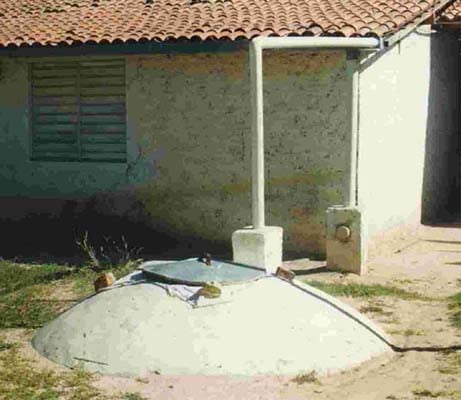 Climate: Semi Arid; Rainwater used as main source
Climate: Semi Arid; Rainwater used as main source
Petrolina is in the semi arid belt of Northeastern Brazil. Rainfall is low and varies greatly year-on-year. A solution to the water-scarcity problem is the use of large (10,000-20,000 litre) tanks that can store enough water to last a frugal household until the next rains. The tanks are usually provided by NGOs as the large structures necessary in this very arid area cost over $200 and are unaffordable for the local population.
- Badulla, Sri Lanka
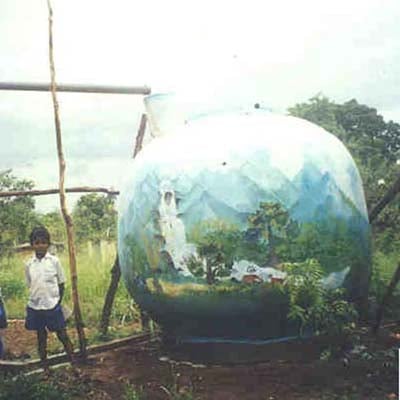 Climate: Tropical, Bimodal ; Rainwater used as main source
Climate: Tropical, Bimodal ; Rainwater used as main source
The town of Badulla is located in a hilly area of Sri Lanka. Groundwater sources are few and tend to be at the bottom of the hills. To reduce the burden of carrying water the local authority provided 5,000 litre ferrocement tanks, at a cost of about $150 which are used for most household water supply. The tanks are now being adopted nationwide for use in areas where access to other protected water sources is difficult.
- Rakai, Uganda
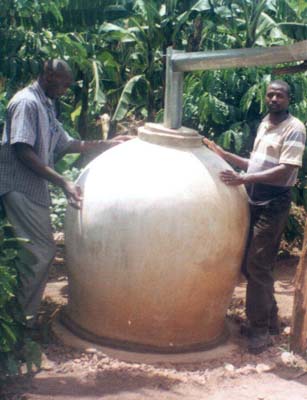 Climate: Tropical, Bimodal; Rainwater used as suplimentary source
Climate: Tropical, Bimodal; Rainwater used as suplimentary source
Rakai is in the southern hills of Uganda. It has a bimodal rainfall pattern and hence a dry season of only 2 months. A local women's group was trained in tank making by a Kenyan women's group and have made a large number of small (700 litre) jars to supplement their water use, particularly in the wet season when they provide the bulk of water needs. The sub $70 cost of the systems are financed by a self sustaining revolving fund.
- Khon Kaen, Thailand
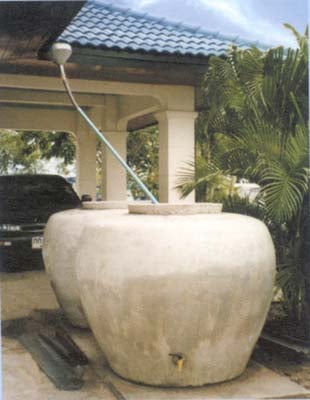 Climate: Tropical, Monsoon; Rainwater used as primary source
Climate: Tropical, Monsoon; Rainwater used as primary source
Northeast Thailand was the scene of one of the world's largest roof water harvesting disseminations. The technology of choice was the 1-2,000 litre "Thai jar" The project passed through several stages with reducing outside intervention, eventually becoming a commercial market producing jars in large numbers for less than $30. This encouraged rapid penetration of rainwater jars and today most houses, rich or poor, have at least one.[3]
International Rainwater Catchment Systems Association (IRCSA)
The purpose of the IRCSA aims to promote and advance rainwater catchment systems technology with respect to planning, development, management, science, technology, research and education worldwide; establish an international forum for scientists, engineers, educators, administrators and those concerned in this field. http://www.ircsa.org/
Primary Objectives of IRCSA
- The promotion and advancement of Rainwater Catchment Systems Technology with respect to planning, development, management, science, technology, research and education world-wide.
- The establishment of an International forum for scientists, engineers, educators, administrators and all others who are, directly or indirectly, concerned in rainwater catchment system programs to link all those working in this field so that information and experiences can be shared.
- The drafting of international guidelines on the use of Rainwater Catchment Systems technology and the updating and dissemination of this information.
- The collaboration with and support of International Programs in the field of Rainwater Catchment Systems including co-operation with other organizations having activities in common.
- The support and continuation of the International Rainwater Catchment Systems Conference series.
Advantages of Rainwater Collection
- Fairly inexpensive
- Easy to reconfigure, expand, or relocate
- Can be installed or expanded on a 'pay as you build' basis
- Reliable
- Water chemistry is easy to manage
- Can be sized to the need at hand, and integrated into new construction easily
- Extremely good back up system
- Can easily be tied into well water system
- Can be put inside a barn, large garage, or in a basement
- Water is still available if you have no power
- Pumps can run off solar or 12 volt systems
- Tanks rarely freeze except in sustained extreme cold due to their thermal mass
- Easy to tie into solar water system
- Most of the system is accessible, so repairs are easy
- Few expensive components
Disadvantages of Rainwater Collection
- Aesthetically intrusive - you have to do something with big tanks
- May not meet local building code requirements for primary water source for new construction
- Requires more ground space than a well for the storage tanks and pumping system
- Requires a good sized roof
- Roof materials and airborne pollutants can pollute the rainwater
- Gutters require constant maintenance and cleaning
Sources for more information
www.harvesth2o.com
www.rainwaterharvesting.tamu.edu
www.gardenwatersaver.com
References
- International Rainwater Catchment Systems Association [5]
- Appropedia Technology Library [6]
